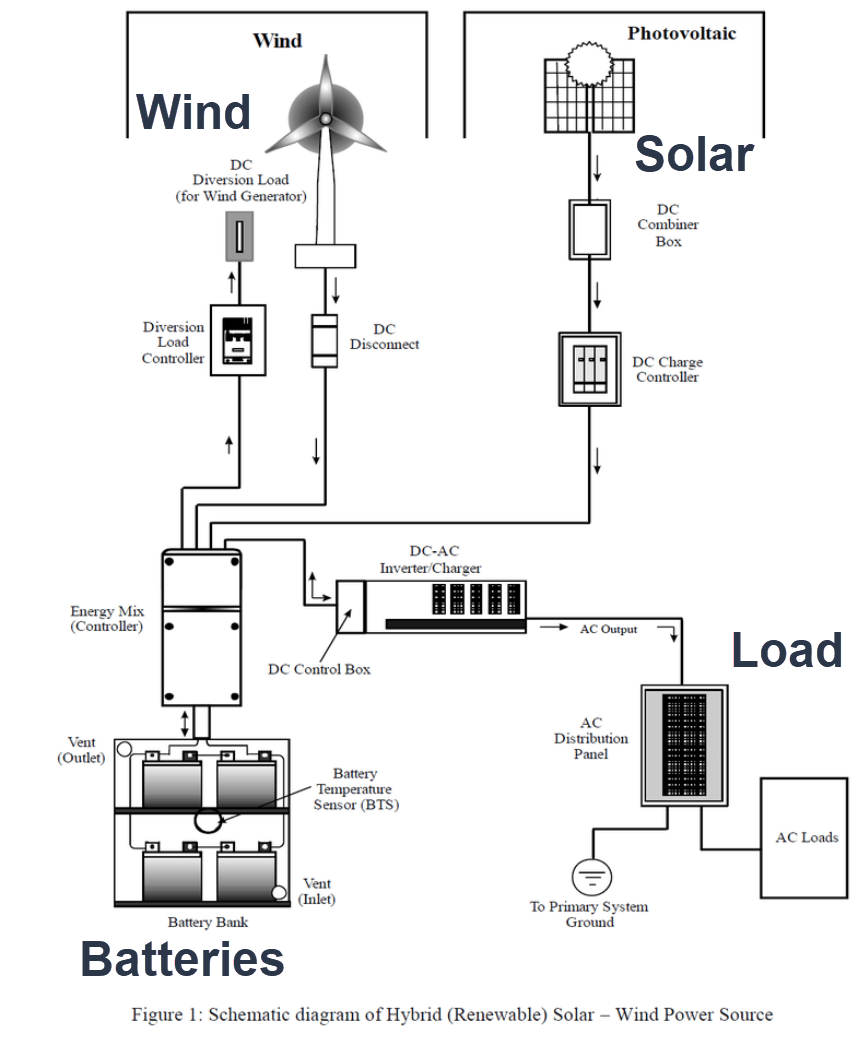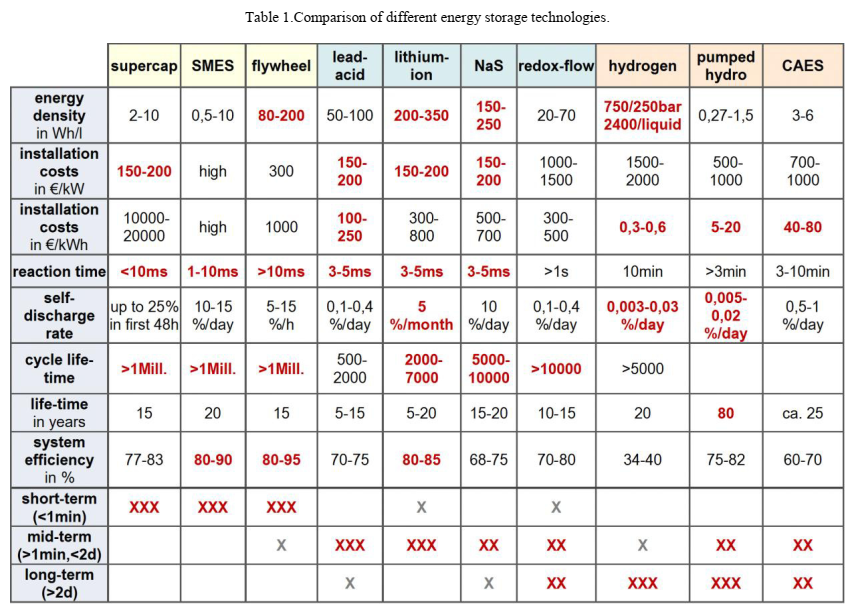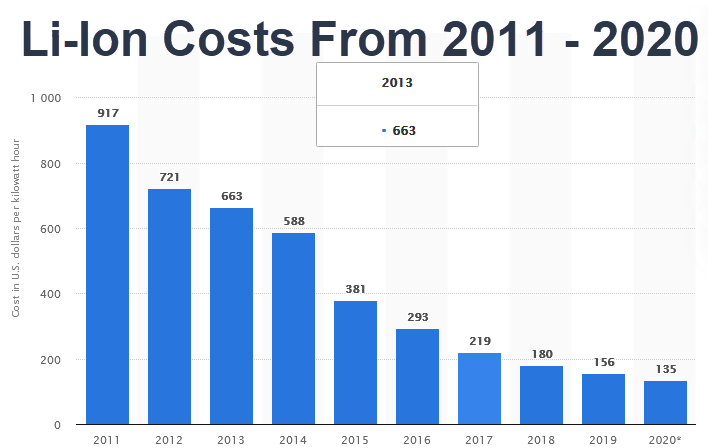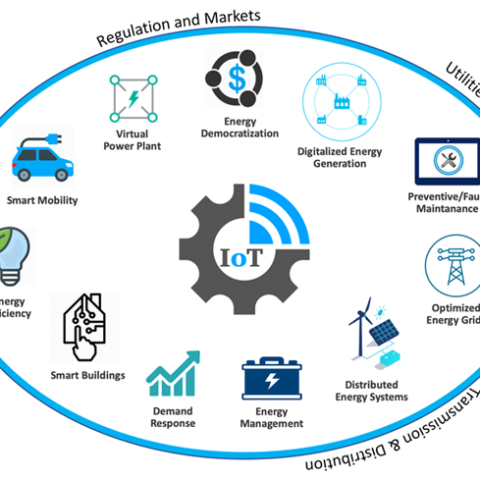Hybrid renewable energy solutions are becoming more popular these days, and more projects are advertising themselves as “hybrid solutions”. So, what exactly are they?
As you might expect from the name, a hybrid solution is a combination of wind and/or solar power with a storage solution (usually a battery). Hybrid solutions can be optimised for energy or power density, varying self-discharge rates, efficiency, and overall lifetimes.
Viewed as a whole, a hybrid is "multiple technologies that are physically and electronically controlled" by the hybrid owner at a single point of interconnection and offered to the market "as a single resource."
Figure 1 shows a generic hybrid solution incorporating wind, PV (solar) and batteries to supply a common load.

Source: “Hybrid Systems Based on the Solar and Wind Potential in the Bania Luka Region”
This combination not only ensures power generation when the wind or sunshine is less than optimal, but also provides high-power availability for energy-dense applications such as machinery start-ups. These are sometimes called “sprinter loads” for their fast and powerful responses.
Exactly what kind of storage capabilities are available depends on what storage is deployed. Table 1 shows the wide range of possibilities:

Source: “Hybrid energy storage systems for renewable energy applications”
By way of example, a hybrid solution addressing “high power” demand and fast load fluctuations requires a fast response time, high efficiency and a high cycle lifetime. A “high energy” storage requires a low self-discharge rate and lower energy specific installation costs.
- Supercapacitors and flywheels offer higher power as well as higher densities, efficiencies and cycle lifetimes compared to batteries, even lithium-ion.
- Redox-flow batteries decouple power and stored energy, as do hydrogen and power-to-gas, while offering good cycle lifetime and recycling capability.
- Renewable hydrogen and methane offer long-term energy storage extending over weeks or even months as “green” analogues to traditional fossil fuels.
- Heat storage and power-to-heat concepts are less well known but may gain importance over time.
High power is often required for mining operations and other use cases involving heavy machinery. This is typically addressed by lithium-ion batteries as these are well understood and supported and are quickly becoming cheaper over time.

Source: Global lithium-ion battery pack costs 2011-2020 (Statista)
This steadily dropping cost curve is a major part of the growing popularly of hybrid solutions.
In fact, Utility Dive reports that “hybrid renewables + storage projects grew even faster in 2019 than previously reported.”
In the U.S. 168 MW / 288 MWh of storage was deployed in Q2 2020. (The 168MW / 288 MWh term means as much as 168 MW of power can be produced at any one instant, while 288 MWh represents the total energy stored. In this case, maximum power could be delivered for 1.7 hours (288 divided by 168) before energy reserves are exhausted.)
That 168 MW / 288 MWh milestone was the industry's second-largest deployment behind Q4 2019, according to a joint report from Wood Mackenzie and the U.S. Energy Storage Association.
Meanwhile, Lawrence Berkeley National Laboratory (LBNL) reports that at the end of 2019, the US alone was home to:
- 40 operational solar + storage projects totaling 882 MW of solar with 169 MW of available power and 446 MWh of total storage, and
- 13 operational wind + storage projects with 1,290 MW of wind and 184 MW of available power and 109 MWh of total storage
Globally, IRENA expects energy storage deployment in emerging markets to increase by over 40% each year until 2025. All this new storage will be part of renewable energy projects.
There are many benefits to building and operating hybrid projects.
The advantages offered by hybrid solutions
When renewable sources and storage are used together in a hybrid solution, special treatment as a variable energy resource is no longer needed.
The low marginal cost and flexibility of renewable energy are rewarded without the need for technology-specific regulations that favor renewables. In fact, a hybrid resource closely resembles a more conventional (i.e. fossil fuel) resource in terms of when and how it can deliver power.
Additionally, a hybrid solution can:
- Avoid the operating constraints usually associated with traditional renewable with no start-up time, no minimum-run time, no minimum-down time, and fast, accurate, controllable, continuous ramping
- Allow the renewable component of the solution to generate at full capacity without the need for curtailment
- Potentially sell energy and ancillary services both the day ahead and in real time markets, ideally during periods offering the highest value, while minimizing the risk of delivering such services
- Increase the project’s lifetime MWh delivered while also ‘right-sizing’ the energy storage solution rather than oversizing it, as is often the case with a single technology
- Deliver double-digit percent capex and opex decreases while increasing the system’s operating life
This is why hybrid solutions are gaining momentum and “energy storage deployments will grow thirteenfold … from a 12 gigawatt-hour market in 2018 to a 158 gigawatt-hour market in 2024” according to GreenTechMedia.
For example, the US already has 4.6GW of utility-scale hybrid resource capacity online and a further 14.7GW in the immediate development pipeline.
Of course, there is also a downside.
The disadvantages posed by hybrid solutions
Location can be an issue with projects seeking to use both wind and solar together. That’s because wind and solar plants should be sited to benefit from strong solar irradiation or wind speed characteristics. Unfortunately, these rarely occur within the same local geographical area.
Advancing technology that produces solar power under less than ideal conditions could help alleviate this issue to some extent.
The next drawback looks to be a more temporary one: hybrid systems are relatively new.
NextEra Energy Vice President of Renewable Energy Policy and Board President of the Energy Systems Integration Group Mark Ahlstrom notes many system operators are "comfortable with conventional plants' quirks and failure modes, while hybrids are unfamiliar."
That unfamiliarity can potentially make it more difficult and/or costly to design and install a hybrid solution due to its added complexity.
Hybrid projects that comprise multiple technologies may also face more rigorous and time-consuming approval processes. The problem lies with a lack of operational data and the comprehensive modelling required for grid operators to consider integrating the proposed system with nationally significant infrastructure.
However, with increasing deployments around the globe, it should soon become more straightforward to accurately determine hybrid configurations which optimise profitability and utility.
Some hybrid solution examples
There are a number of hybrid solutions being developed as this article was published:
- India-based Greenko won a tender for 900MW of solar paired with pumped hydro energy storage as part of a 1.2GW procurement by the national Solar Energy Corporation of India (SECI).
- Paris-based renewable operator Neoen unveiled plans for a major hybrid power plant in South Australia which will combine 1.2GW of wind, 600MW of solar PV and a 900MW battery storage facility.
- Swedish multinational power giant Vattenfall is about to complete a new hybrid energy park consisting of solar panels, wind turbines and batteries in the Netherlands with 60MW total capacity.
- Spanish energy giant Iberdrola is building a 320MW hybrid wind and solar project near Port Augusta in South Australia which will feature a proposed second stage comprised of more solar PV and a “big battery”.
- Gold Fields Group is building a project comprised of an 18 MW wind farm, a 10,000 panel 4 MW solar farm and a 13 MW / 4 MWh battery storage alongside a 16 MW gas engine power station, making it the first large hybrid microgrid in the mining sector in Australia to integrate wind generation.
- Oil major Shell and Dutch utility Eneco will build a super-hybrid offshore wind farm in the Netherlands which includes a 759 MW offshore wind farm with solar, storage and hydrogen elements.
- Siemens Gamesa is working on a hybrid energy project in the Philippines to combine an existing 16MW wind farm, battery storage and an in-house central control system already managing the energy produced at the plant.
Each project represents a significant technological advance towards making renewables an energy source that can be used on demand.
Furthermore, hybrid solutions should quickly become an increasingly common project choice in the future as more becomes known about their flexibility, efficiency and economics.
When hybrid solutions make sense for your proposed or existing project
If your firm is currently involved with a hybrid project or contemplating investing in one, you must assess your needs and decide which combination of resources best meet those needs.
Points to consider:
- Each location has its own specifics about the availability of wind and solar radiation, including data on their intensity and distribution in the selected area.
- There are a wide variety of storage solutions, with even the most common option (lithium ion batteries) optimizable to provide high power or high energy needs. Which does your project require most?
- The optimization process must include economic and financial analysis of a wide variety of energy and storage solutions to confirm the system’s feasibility. Some solutions may require more than one kind of storage to provide both high power and high energy availability.
- Any hybrid solution outside the main distribution network (i.e. in a remote or rural area) can support the sustainability of such areas, improve communities’ quality of life and thus can be used as a selling point when negotiating with regulatory bodies for approval.
- Any hybrid system can potentially be augmented with new components representing new sources of energy, such as small hydro or fuel cells, as technology becomes available and dynamic cost structures make them economical
The answers must be incorporated into short, medium and long-term action plans that feature a robust performance and risk framework with sufficient flexibility for fine-tuning and stress-testing.
Are you prepared to seize the advantages offered by the rapid growth of renewable hybrid projects?
How ADC Projects Can Help
At ADC Projects, we sell expertise in the energy market to commerce and industry, including both big and small hybrid solutions. We provide Project Development, Project Management and Engineering consulting services to develop and install a variety of renewable power projects.
To learn more about becoming less dependent on utility power, saving time & money and gaining a real advantage over your competition, please contact us today.










